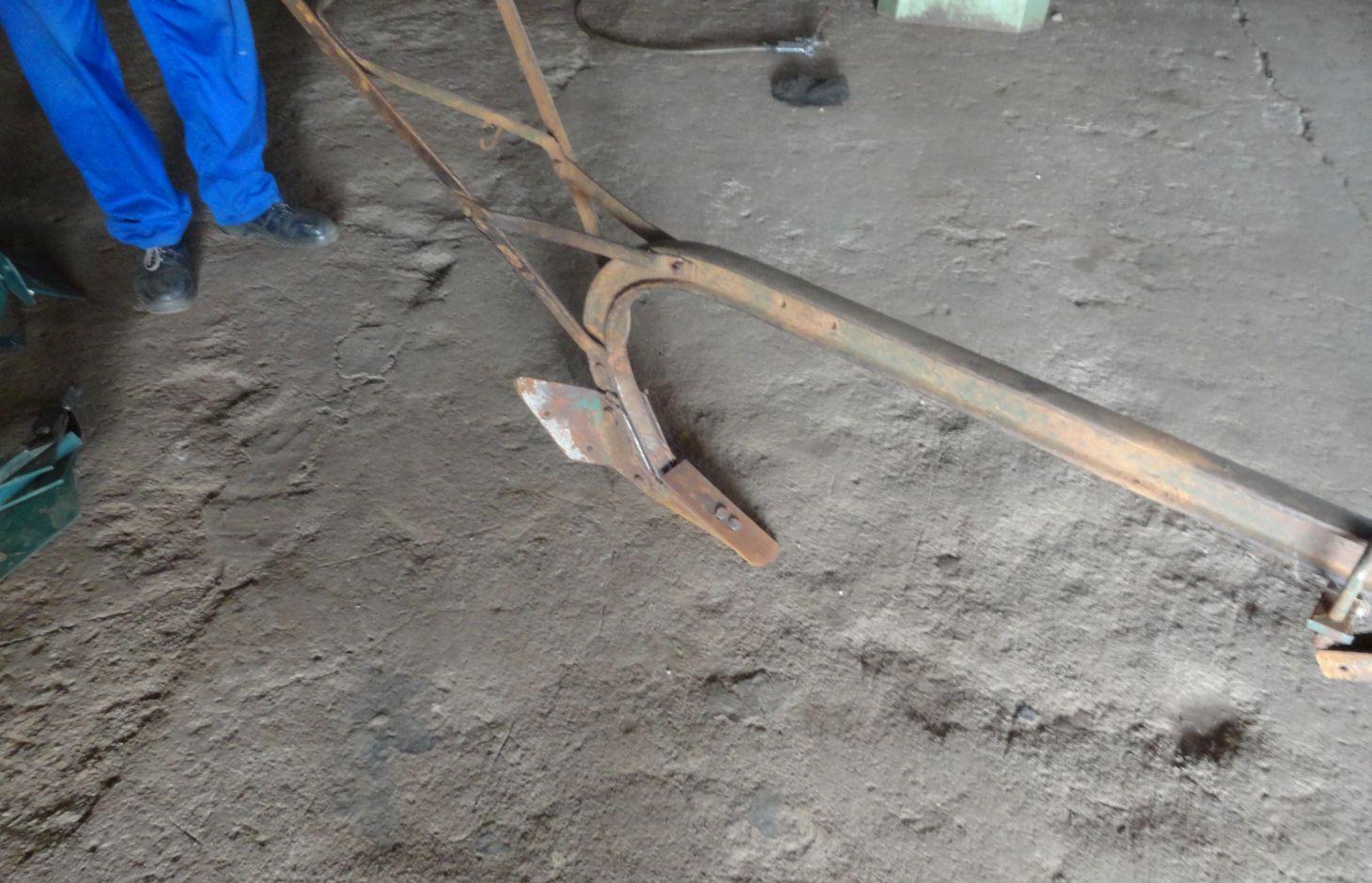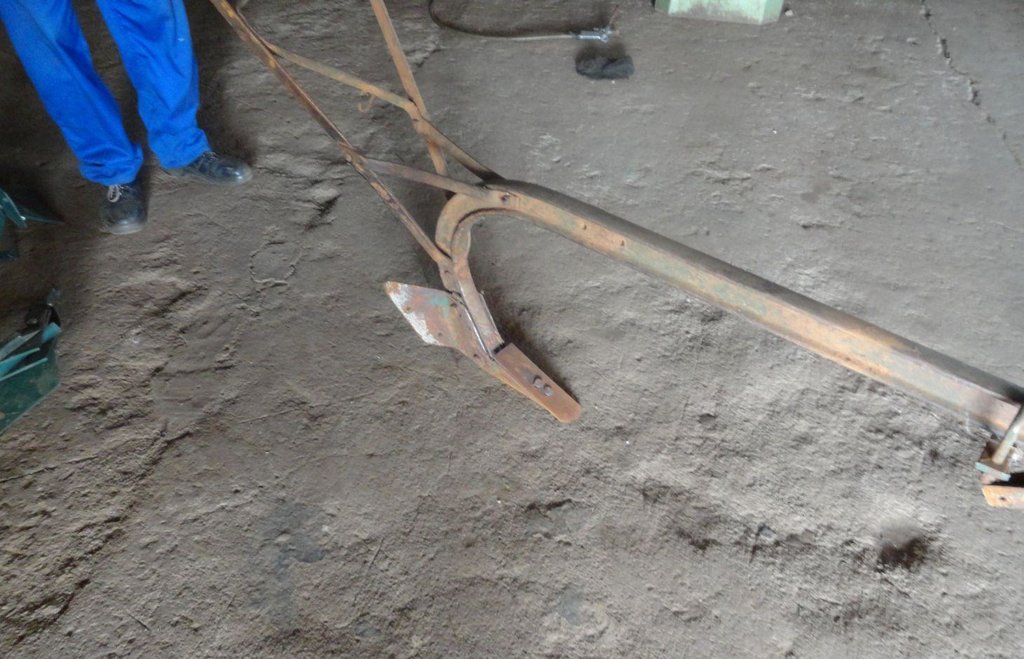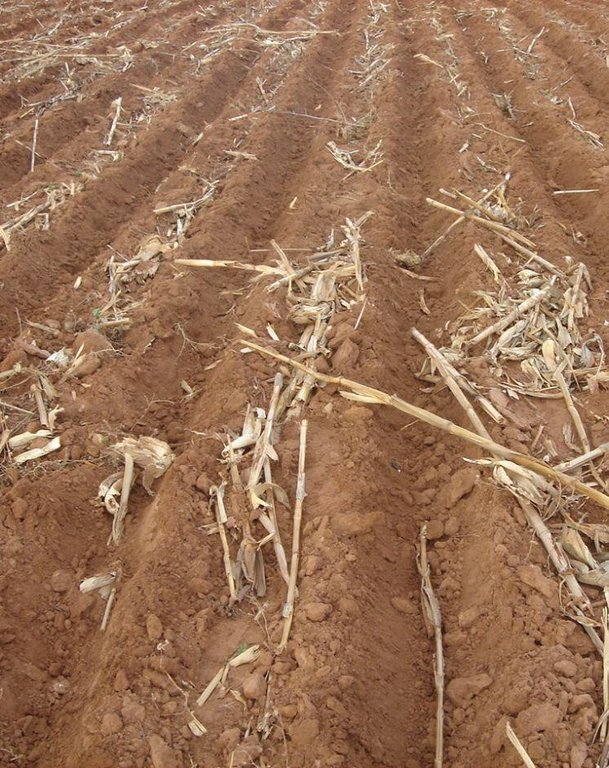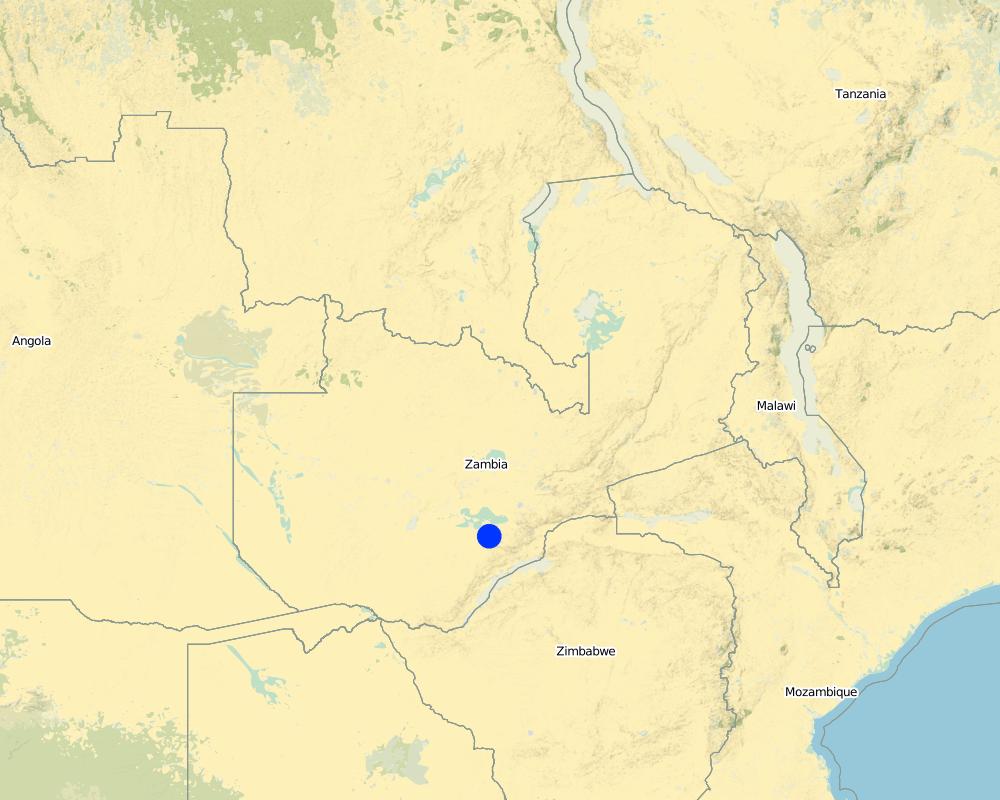Conservation Tillage with Magoye Ripper [Zambia]
- Creation:
- Update:
- Compiler: Silenga Wamunyima
- Editor: –
- Reviewer: Fabian Ottiger
Minimum tillage
technologies_1139 - Zambia
View sections
Expand all Collapse all1. General information
1.2 Contact details of resource persons and institutions involved in the assessment and documentation of the Technology
SLM specialist:
SLM specialist:
Katoweji Alfred
(+260) 211 213 739
Golden Valley Agricultural Research Trust
PO. Box 50834 Lusaka
Zambia
SLM specialist:
Ndandula Sharon
(+260) 211 213 739
Golden Valley Agricultural Research Trust
PO. Box 50834 Lusaka
Zambia
Name of the institution(s) which facilitated the documentation/ evaluation of the Technology (if relevant)
Golden Valley agricultural research trust (Golden Valley agricultural research trust) - Zambia1.3 Conditions regarding the use of data documented through WOCAT
When were the data compiled (in the field)?
15/01/2013
The compiler and key resource person(s) accept the conditions regarding the use of data documented through WOCAT:
Yes
1.5 Reference to Questionnaire(s) on SLM Approaches
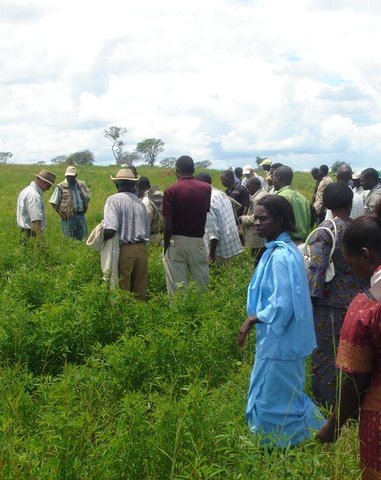
Participatory Research and Development [Zambia]
This is a collaborative process between researchers and farmers for developing and adapting new technologies that focus on incorporating the perspectives and inputs from the farmers into the development process.
- Compiler: Arthur Chomba
2. Description of the SLM Technology
2.1 Short description of the Technology
Definition of the Technology:
Conservation Tillage with the Magoye Ripper is an animal draft reduced tillage method that involves the use of the Magoye Ripper to loosen the soil by shattering with a tine instead of ploughing.
2.2 Detailed description of the Technology
Description:
The Magoye Ripper is an animal drawn implement used for conservation tillage. The Ripper consists of a frame that is attached to a common plough beam and on this frame is fixed a tine at an angle that penetrates and breaks up the soil when pulled. Only the region where the crop furrow will be is loosened by the tine and by so doing reducing the amount of tillage and disruption of soil structure while preserving the crop residue cover. The frame has some ‘wings’ attached to it that throw the soil out of the ripped furrow to leave it open for planting and collecting of water. Ripping is done in one pass up to a depth of 15cm depending on the strength of the oxen, soil type, hitch assembly settings and the sharpness of the tine.
Purpose of the Technology: Reducing tillage first of all reduces tillage costs and tillage time allowing more time for the farmer to plant early and/or a bigger area. Reducing tillage also reduces the loss of soil organic matter and the destructive effects to the soil structure ultimately improving soil fertility and soil water conservation. Ripping does not invert the soil, hence it does not bury crop residues which further enhance organic matter levels and protect the soil from excessive evaporation and erosion. The open furrow left by the ripper collects water from the adjacent untilled soil much in the same way basins (zai system) are used for water harvesting. This together with the increased rooting depth resulting from the breaking of compacted soil, enhanced infiltration and early planting improves water conservation and hence the resilience of crop to extended dry spells.
Establishment / maintenance activities and inputs: The establishment of ripping based conservation tillage mainly involves the purchase of the ripper frame and the
replaceable tines. Liming acidic soils (low pH soils) followed by a final ploughing will be required to correct the soil pH which otherwise will be difficult to correct once conservation tillage has been established. The main establishment activity involves adopting a new mindset and increasing the knowledge base to apply the technology correctly. Knowledge about alternative weed control practices and herbicide use is particularly cardinal as the farmer will have to adopt new weeding practices and routines in the absence of ploughing. Maintenance activities are more or less the same as conventional tillage except for replacing the tillage tines which wear every now and then. The same applies for the inputs except for the increase in use of herbicides.
Natural / human environment: Ripping is best performed in dry season when the soil is dry although this may not be possible with some of the smaller and/or weak oxen when the soil is too dry. It is therefore recommended for farmers in regions that experience long dry seasons to rip at the end of harvest before the soils get too dry and hard and when the oxen are in good condition before they lose weight and strength due to less feed and water, excessive heat as the dry season progresses.
The ripper is mostly suited to small-scale farmers just adopting Conservation Agriculture (CA) since the tool can be easily adapted to the existing plough beam which most of the farmers already have. The small capital outlay for establishing the system makes it suited to resource poor and risk-averse farmers.
2.3 Photos of the Technology
2.5 Country/ region/ locations where the Technology has been applied and which are covered by this assessment
Country:
Zambia
Region/ State/ Province:
Zambia/Southern Province
Further specification of location:
Mazabuka/Magoye
Map
×2.6 Date of implementation
If precise year is not known, indicate approximate date:
- 10-50 years ago
2.7 Introduction of the Technology
Specify how the Technology was introduced:
- during experiments/ research
Comments (type of project, etc.):
The Magoye Ripper was introduced in 1995 after a period of adaptive research by government research branch under a project supported by the Netherlands government.
3. Classification of the SLM Technology
3.1 Main purpose(s) of the Technology
- reduce, prevent, restore land degradation
3.2 Current land use type(s) where the Technology is applied

Cropland
- Annual cropping
Main crops (cash and food crops):
Major cash crop: Cotton, maize
Major food crop: Maize
Major other crops: Groundnuts

Mixed (crops/ grazing/ trees), incl. agroforestry
- Agro-pastoralism
Main products/ services:
Main species seminomadism/pastoralism: Cattle, goats, pigs
Comments:
Major land use problems (compiler’s opinion): Loss of soil structure and loss of soil fertility
Major land use problems (land users’ perception): Droughts and dry dpells
Livestock is grazing on crop residues
3.3 Further information about land use
Water supply for the land on which the Technology is applied:
- rainfed
Number of growing seasons per year:
- 1
Specify:
Longest growing period in days: 135 Longest growing period from month to month: Mid November to end of March
Livestock density (if relevant):
1-10 LU /km2
3.4 SLM group to which the Technology belongs
- minimal soil disturbance
3.5 Spread of the Technology
Specify the spread of the Technology:
- evenly spread over an area
If the Technology is evenly spread over an area, indicate approximate area covered:
- 0.1-1 km2
Comments:
250 rippers were distributed in Magoye and surveys show that only about half of these farmers continued to use the ripper. The field sizes range from 1/4ha to 1/2ha.
3.6 SLM measures comprising the Technology

agronomic measures
- A2: Organic matter/ soil fertility
- A6: Others
Comments:
Main measures: agronomic measures
Specification of other agronomic measures: Reduced Tillage, Crop Residues
Type of agronomic measures: early planting, mulching, manure / compost / residues, mineral (inorganic) fertilizers, soil conditioners (lime, gypsum), rotations / fallows, breaking compacted topsoil, minimum tillage, non-inversion tillage, furrows (drainage, irrigation), breaking compacted subsoil
3.7 Main types of land degradation addressed by the Technology

soil erosion by water
- Wt: loss of topsoil/ surface erosion

chemical soil deterioration
- Cn: fertility decline and reduced organic matter content (not caused by erosion)

physical soil deterioration
- Pc: compaction

biological degradation
- Bl: loss of soil life
Comments:
Main type of degradation addressed: Cn: fertility decline and reduced organic matter content, Pc: compaction, Bl: loss of soil life
Secondary types of degradation addressed: Wt: loss of topsoil / surface erosion
Main causes of degradation: soil management (Over-ploughing), crop management (annual, perennial, tree/shrub) (Monocropping), overgrazing (Crop residues overgrazed leaving land exposed), poverty / wealth (under application of fertilizer leading to nutrient mining, charcoal burning)
Secondary causes of degradation: deforestation / removal of natural vegetation (incl. forest fires) (Charcoal burning), Heavy / extreme rainfall (intensity/amounts) (high intensity storms leading to erosion), droughts (resulting in inadequate soil cover), land tenure (communal land over-exploited), governance / institutional (lack of credit facilities)
3.8 Prevention, reduction, or restoration of land degradation
Specify the goal of the Technology with regard to land degradation:
- reduce land degradation
Comments:
Secondary goals: prevention of land degradation, rehabilitation / reclamation of denuded land
4. Technical specifications, implementation activities, inputs, and costs
4.1 Technical drawing of the Technology
Author:
Silenga Wamunyima, Box 670577, Mazabuka, Zambia
4.2 Technical specifications/ explanations of technical drawing
Planting rip lines are done at a depth of 15-20 cm with inter row of 75 or 90 cm, 30-40 cm depth of the furrow of ripping can be achieved. This is achieved by running the ripper through the same rip line twice so that the tine gets deeper into the soil. The width of the open furrow is 10-15 cm wide. Ripping is done across the slope to reduce runoff. Ripping is best performed and recommended done in the dry season.
Location: Magoye. Mazabuka/Southern Province/Zambia
Date: 2014-06-29
Technical knowledge required for field staff / advisors: high (The use of the Ripper itself is simple but applying it as part of a conservation agriculture system can be knowledge demanding.)
Technical knowledge required for land users: moderate (adapting the production system to accommodate the Ripper will require learning new practices for weeding, planting and fertility management.)
Main technical functions: improvement of ground cover, improvement of topsoil structure (compaction), improvement of subsoil structure (hardpan), increase of infiltration, water harvesting / increase water supply
Secondary technical functions: control of raindrop splash, improvement of surface structure (crusting, sealing), increase in organic matter, increase in nutrient availability (supply, recycling,…), increase / maintain water stored in soil, increase of groundwater level / recharge of groundwater
Early planting
Material/ species: maize, cotton
Quantity/ density: 44,000 pla
Remarks: 25cm intra row by 75cm
Mulching
Material/ species: crop residues
Quantity/ density: 3ton/ha
Remarks: uniformly spread
Manure / compost / residues
Material/ species: residues
Quantity/ density: 3ton/ha
Remarks: uniformly spread
Mineral (inorganic) fertilizers
Material/ species: Basal and top dressing
Quantity/ density: 400kg/ha
Remarks: spot application
Soil conditioners (lime, gypsum)
Material/ species: lime
Quantity/ density: 1ton/ha
Rotations / fallows
Material/ species: maize in rotation with cotton, groundnuts and cowpeas
Breaking compacted topsoil
Material/ species: Ripping with Magoye Ripper at 15cm depth
Remarks: 75cm or 90cm row spacing
Minimum tillage
Material/ species: ripping
Non-inversion tillage
Material/ species: ripping
Furrows (drainage, irrigation)
Material/ species: ripped lines leave furrows for water harvesting
Breaking compacted subsoil
Material/ species: deep ripping at 20cm
4.3 General information regarding the calculation of inputs and costs
other/ national currency (specify):
Kwacha
Indicate exchange rate from USD to local currency (if relevant): 1 USD =:
5.0
Indicate average wage cost of hired labour per day:
2.40
4.4 Establishment activities
| Activity | Type of measure | Timing | |
|---|---|---|---|
| 1. | Purchase magoye ripper | Agronomic | |
| 2. | Purchase knapsack sprayer | Agronomic |
Comments:
Lifespan of the magoye ripper: 7 years
Lifespan of the Knapsack sprayer: 5 years
4.5 Costs and inputs needed for establishment
| Specify input | Unit | Quantity | Costs per Unit | Total costs per input | % of costs borne by land users | |
|---|---|---|---|---|---|---|
| Equipment | Magoye ripper | Tool | 1.0 | 50.0 | 50.0 | 100.0 |
| Equipment | Knapsack sprayer | Tool | 1.0 | 80.0 | 80.0 | 100.0 |
| Total costs for establishment of the Technology | 130.0 | |||||
Comments:
Duration of establishment phase: 5 month(s)
4.6 Maintenance/ recurrent activities
| Activity | Type of measure | Timing/ frequency | |
|---|---|---|---|
| 1. | slashing and spreading residues | Agronomic | May-June yearly after harvest |
| 2. | Ripping | Agronomic | May-June after harvest |
| 3. | Liming | Agronomic | Nov-Dec before planting |
| 4. | Planting and fertilizing | Agronomic | Nov-Dec at onset of rains |
| 5. | chemical weeding | Agronomic | 3 times |
| 6. | harvesting | Agronomic | April-May |
4.7 Costs and inputs needed for maintenance/ recurrent activities (per year)
| Specify input | Unit | Quantity | Costs per Unit | Total costs per input | % of costs borne by land users | |
|---|---|---|---|---|---|---|
| Labour | Slashing and spreading residues | ha | 1.0 | 20.0 | 20.0 | 100.0 |
| Labour | Ripping | ha | 1.0 | 50.0 | 50.0 | 100.0 |
| Labour | Liming | ha | 1.0 | 42.0 | 42.0 | 100.0 |
| Labour | Planting and fertilizing | ha | 1.0 | 40.0 | 40.0 | 100.0 |
| Plant material | Seeds | kg | 20.0 | 2.5 | 50.0 | 100.0 |
| Fertilizers and biocides | Fertilizer | kg | 400.0 | 0.8 | 320.0 | 100.0 |
| Other | Herbicides | liters | 5.0 | 6.0 | 30.0 | 100.0 |
| Other | Labour: Chemical weeding | ha | 1.0 | 24.0 | 24.0 | 100.0 |
| Other | Labour: Harvesting | ha | 1.0 | 20.0 | 20.0 | 100.0 |
| Total costs for maintenance of the Technology | 596.0 | |||||
Comments:
Machinery/ tools: Magoye Ripper
Calculation are for a 1ha of maize under magoye ripper based conservation tillage and costs are for the Zambia situation in Magoye as of August 2012.
4.8 Most important factors affecting the costs
Describe the most determinate factors affecting the costs:
The weed control method employed is the main determinate factor depending on whether the farmer uses hand hoe or herbicides. Abandoning ploughing leads to higher weed densities leading to increased labour requirements/recurrent costs if hand weeding is used. However, with herbicides the weeding labour demand and costs cost are much lower by a factor of about 5. Another major cost is that of fertilizer which makes up about half the cost hence the total cost will vary significantly depending on fertilizer cost.
5. Natural and human environment
5.1 Climate
Annual rainfall
- < 250 mm
- 251-500 mm
- 501-750 mm
- 751-1,000 mm
- 1,001-1,500 mm
- 1,501-2,000 mm
- 2,001-3,000 mm
- 3,001-4,000 mm
- > 4,000 mm
Specifications/ comments on rainfall:
Average rainfall 700mm, summer rains from November to March.
Agro-climatic zone
- semi-arid
Thermal climate class: subtropics. 3 distinct seasons – summer, winter and one rainy season
5.2 Topography
Slopes on average:
- flat (0-2%)
- gentle (3-5%)
- moderate (6-10%)
- rolling (11-15%)
- hilly (16-30%)
- steep (31-60%)
- very steep (>60%)
Landforms:
- plateau/plains
- ridges
- mountain slopes
- hill slopes
- footslopes
- valley floors
Altitudinal zone:
- 0-100 m a.s.l.
- 101-500 m a.s.l.
- 501-1,000 m a.s.l.
- 1,001-1,500 m a.s.l.
- 1,501-2,000 m a.s.l.
- 2,001-2,500 m a.s.l.
- 2,501-3,000 m a.s.l.
- 3,001-4,000 m a.s.l.
- > 4,000 m a.s.l.
Comments and further specifications on topography:
Slopes on average: Also flat and moderate (classed 2) and rolling (classed 3)
5.3 Soils
Soil depth on average:
- very shallow (0-20 cm)
- shallow (21-50 cm)
- moderately deep (51-80 cm)
- deep (81-120 cm)
- very deep (> 120 cm)
Soil texture (topsoil):
- medium (loamy, silty)
- fine/ heavy (clay)
Topsoil organic matter:
- medium (1-3%)
- low (<1%)
If available, attach full soil description or specify the available information, e.g. soil type, soil PH/ acidity, Cation Exchange Capacity, nitrogen, salinity etc.
Soil fertility: Low (classed 1) and medium (classed 2, low fertility caused mainly by poor soil management practices, otherwise soil are inherently fertile)
Topsoil organic matter: Low (classed 1) and medium (classed 2, due to excessive ploughing and nutrient mining)
Soil drainage/infiltration: Good (classed 1, soils naturally are well drained except were soil have bee compacted by poor management practices) and medium (classed 2)
Soil water storage capacity: Medium (classed 1, soils mostly loam to sandy loam with medium storage capacity) and low (ranked 2)
5.4 Water availability and quality
Ground water table:
> 50 m
Availability of surface water:
medium
Water quality (untreated):
good drinking water
Comments and further specifications on water quality and quantity:
Ground water table: <50m (ranked 1, hand wells are <20m but reliable boreholes are > 50m) and 5-50m (ranked 2)
Availability of surface water: Medium (mostly seasonal streams and dams)
Water quality (untreated): Good drinking water (ranked 1, from hand pumps (both communal and private)) and poor drinking water (treatment required, from hand dug wells, ranked 1 also)
5.5 Biodiversity
Species diversity:
- medium
Comments and further specifications on biodiversity:
Human population densities are relatively low
5.6 Characteristics of land users applying the Technology
Off-farm income:
- 10-50% of all income
Relative level of wealth:
- very poor
- poor
Individuals or groups:
- individual/ household
Gender:
- men
Indicate other relevant characteristics of the land users:
Land users applying the Technology are mainly common / average land users
Difference in the involvement of women and men: The technology is applied mostly by men since most households are male headed and animal traction operation are reserved for men. Planting and weeding operations are the domain of women and children
Population density: 10-50 persons/km2
Annual population growth: 3% - 4%
8% of the land users are rich and own 15% of the land (own more than 10 cattle).
8% of the land users are average wealthy and own 15% of the land (own between 5 and 10 cattle).
16% of the land users are poor and own 20% of the land (own less than 5).
68% of the land users are poor and own 40% of the land (do not own cattle).
Off-farm income specification: sale of rainfed crops makes up about half of their income, the remainder coming from sale of livestock, petty trading, hiring out labour and remittances
Market orientation of production system: Mixed (subsistence/ commercial, sale of excess maize and cotton, dairy, ranked 1) and subsistence (self-supply, livestock, maize and legumes for home consumption, ranked 2),
Level of mechanization: Animal traction (ranked 1, families without cattle borrow or hire), mechanised (ranked 2) and manual labour (ranked 2, only for small backyard fields)
5.7 Average area of land owned or leased by land users applying the Technology
- < 0.5 ha
- 0.5-1 ha
- 1-2 ha
- 2-5 ha
- 5-15 ha
- 15-50 ha
- 50-100 ha
- 100-500 ha
- 500-1,000 ha
- 1,000-10,000 ha
- > 10,000 ha
Is this considered small-, medium- or large-scale (referring to local context)?
- small-scale
Comments:
Average area of land owned or leased by land users applying the Technology: Also: 5-15 ha, 15-50 ha, 50-100 ha
5.8 Land ownership, land use rights, and water use rights
Land ownership:
- individual, not titled
Land use rights:
- open access (unorganized)
- individual
- Land is apportioned by traditional leaders
Water use rights:
- open access (unorganized)
- Land is apportioned by traditional leaders
5.9 Access to services and infrastructure
health:
- poor
- moderate
- good
education:
- poor
- moderate
- good
technical assistance:
- poor
- moderate
- good
employment (e.g. off-farm):
- poor
- moderate
- good
markets:
- poor
- moderate
- good
energy:
- poor
- moderate
- good
roads and transport:
- poor
- moderate
- good
drinking water and sanitation:
- poor
- moderate
- good
financial services:
- poor
- moderate
- good
6. Impacts and concluding statements
6.1 On-site impacts the Technology has shown
Socio-economic impacts
Production
crop production
Quantity before SLM:
1.8ton/ha
Quantity after SLM:
2ton/ha
Comments/ specify:
mostly due to early planting
fodder production
Comments/ specify:
crop residues needed for soil cover
risk of production failure
Comments/ specify:
Better tolerance to dry spells
production area
Quantity after SLM:
20%
Income and costs
expenses on agricultural inputs
Comments/ specify:
purchase of herbicides
farm income
Quantity after SLM:
15%
Comments/ specify:
due to lower tillage cost, better yield
workload
Comments/ specify:
only if herbicicdes are used for weeding
Socio-cultural impacts
food security/ self-sufficiency
Comments/ specify:
due to improved yields and more time and labour to diversify
recreational opportunities
Comments/ specify:
Less time spent preparing land
conflict mitigation
Comments/ specify:
competition for crop residues with neighbours cattle
Improved livelihoods and human well-being
Comments/ specify:
Technology not yet been applied on a large enough area to make significant impact at community level but increased farm incomes among farmers has led to better education and health among household members.
Ecological impacts
Water cycle/ runoff
water quality
Comments/ specify:
due to improved good drainage
harvesting/ collection of water
Comments/ specify:
open furows collect water
surface runoff
Comments/ specify:
due to better soil cover
excess water drainage
Comments/ specify:
due to improved soil structure
groundwater table/ aquifer
Comments/ specify:
not applied extensively
evaporation
Comments/ specify:
due to better soil cover
Soil
soil moisture
Comments/ specify:
due to resulting improved soil srtucture
soil cover
Comments/ specify:
Due to non-inversion tillage
soil loss
Comments/ specify:
Due to less soil disturbance and better soil cover
soil crusting/ sealing
Comments/ specify:
Due to less soil disturbance
soil compaction
Comments/ specify:
Due to less soil disturbance
nutrient cycling/ recharge
Comments/ specify:
Due to less soil disturbance
salinity
Comments/ specify:
due to resulting good drainage
soil organic matter/ below ground C
Comments/ specify:
Due to less soil disturbance
Biodiversity: vegetation, animals
biomass/ above ground C
Comments/ specify:
Due to less soil disturbance
animal diversity
Comments/ specify:
due to increased soil organic matter (SOM)
Other ecological impacts
Waterlogging
Comments/ specify:
Open furrow collect water in times of excess rainfal
Soil erosion locally
Comments/ specify:
If furrow are made along the slope
6.2 Off-site impacts the Technology has shown
water availability
Comments/ specify:
only if applied on a large scale
reliable and stable stream flows in dry season
Comments/ specify:
only if applied on a large scale
downstream flooding
Comments/ specify:
only if applied on a large scale
downstream siltation
Comments/ specify:
only if applied on a large scale
groundwater/ river pollution
Comments/ specify:
only if applied on a large scale
damage on neighbours' fields
Comments/ specify:
only if applied on a large scale
6.3 Exposure and sensitivity of the Technology to gradual climate change and climate-related extremes/ disasters (as perceived by land users)
Gradual climate change
Gradual climate change
| Season | Type of climatic change/ extreme | How does the Technology cope with it? | |
|---|---|---|---|
| annual temperature | increase | not known |
Climate-related extremes (disasters)
Meteorological disasters
| How does the Technology cope with it? | |
|---|---|
| local rainstorm | not well |
| local windstorm | not known |
Climatological disasters
| How does the Technology cope with it? | |
|---|---|
| drought | well |
Hydrological disasters
| How does the Technology cope with it? | |
|---|---|
| general (river) flood | not well |
Other climate-related consequences
Other climate-related consequences
| How does the Technology cope with it? | |
|---|---|
| reduced growing period | well |
Comments:
Magoye ripper based conservation tillage should be applied in well drained fields to avoid water-logging in the ripped furrows during seasons of excess rainfall or events of heavy downpours.
6.4 Cost-benefit analysis
How do the benefits compare with the establishment costs (from land users’ perspective)?
Short-term returns:
positive
Long-term returns:
very positive
How do the benefits compare with the maintenance/ recurrent costs (from land users' perspective)?
Short-term returns:
positive
Long-term returns:
very positive
Comments:
Timely planting enables larger areas to be planted and better yields. In the long term, improved soil fertility and soil structure results in sustained improved yields. However, if herbicides are not used, the costs and labour requirements of weeding can result in negative benefits.
6.5 Adoption of the Technology
Comments:
250 land user families have adopted the Technology with external material support
Comments on acceptance with external material support: The farmers bought the Magoye Rippers at half price and over half of them abandoned the technology after the first or second year of use.
Comments on spontaneous adoption: Information on spontaneous adoption is not documented although there have been reports of this in other districts.
There is a little trend towards spontaneous adoption of the Technology
Comments on adoption trend: Availability of replacement tines and the increased weed challenge have been a major hindrances to widespread adoption.
6.7 Strengths/ advantages/ opportunities of the Technology
| Strengths/ advantages/ opportunities in the land user’s view |
|---|
|
Enables early planting How can they be sustained / enhanced? planting with the first heavy rainfall in November |
| Strengths/ advantages/ opportunities in the compiler’s or other key resource person’s view |
|---|
|
necessitates early planting How can they be sustained / enhanced? Plant in November or early December with the onset of rainfall |
|
fewer operations hence lower costs How can they be sustained / enhanced? continuous emphasis on early land preparation (May to July/August) |
|
conserves water and soil How can they be sustained / enhanced? encourage crop diversification and crop rotation legumes |
6.8 Weaknesses/ disadvantages/ risks of the Technology and ways of overcoming them
| Weaknesses/ disadvantages/ risks in the land user’s view | How can they be overcome? |
|---|---|
| weeding is difficult when herbicides are not used | train land users on how to use herbicides |
| ripping is hardly attained in heavy soils in October | rip between May and July |
| Weaknesses/ disadvantages/ risks in the compiler’s or other key resource person’s view | How can they be overcome? |
|---|---|
| weed pressure | encourage land users to use herbicides and continuous weeding |
7. References and links
7.2 References to available publications
Title, author, year, ISBN:
Impact study on the acceptance of the Magoye Ripper, Piet Stevens, David Samazaka, Ab Wanders, Douglas Moono, 2002
Available from where? Costs?
GART/free
Title, author, year, ISBN:
Social-economic analysis of conservation agriculture in southern Africa, FAO, 2011
Available from where? Costs?
FAO/free online
Title, author, year, ISBN:
Conservation farming in Zambia, Steven Haggblade, Gelson Tembo, October 2003
Available from where? Costs?
INDABA Project, Michigan State University/free online.
Title, author, year, ISBN:
Conservation farming in Zambia, Conservation farming unit (CFU), 2011
Available from where? Costs?
cfu@zamnet.zm
Links and modules
Expand all Collapse allLinks

Participatory Research and Development [Zambia]
This is a collaborative process between researchers and farmers for developing and adapting new technologies that focus on incorporating the perspectives and inputs from the farmers into the development process.
- Compiler: Arthur Chomba
Modules
No modules


